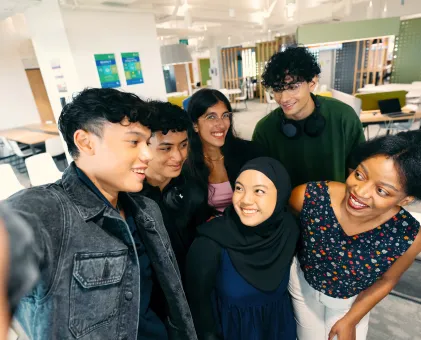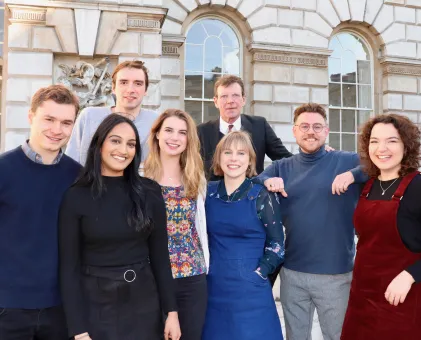Move over user-generated content, it's time for ambassador-generated content!

Prospective students are increasingly using social media to help with their higher education choices - 70% of prospects use it at some point in the application process according to the 2020 QS UK Domestic Student Survey. Why not take advantage of this and use social media to directly connect those prospective students with your Student Ambassadors and allow those incredibly powerful conversations to happen?
But, how to do this? Well, a highly-effective way is to harness the power of the fantastic content your Ambassadors are creating for you, and use it to cut through the noise and really make an impression on a prospective student.
You need to be creating and sharing thumb-stopping content that makes people stop scrolling and start paying attention, and then use that content to drive prospects to your Ambassadors and allow those valuable conversations to take place.
In this article, we’ll cover why using your Ambassadors’ content is such a powerful tool. We'll pick out some ideas and examples, and show you how easy all of this is on our platform.
If you're interested in finding out more about our platform, and our period of three months' free usage for all new partners, hit the button below and book a demo!
The power of Ambassador-generated content
For many years now, user-generated content (UGC) has been an influential part of any social media marketing mix. Social campaigns that incorporate UGC see a 50% lift in engagement (Salesforce), 75% of people think UGC makes content more authentic (TintUp), and 35% of Gen-Z think that, by 2023, UGC will have more credibility than traditional content created by a company or independent source (Cognizant).
In fact, as long ago as 2014, there was data to show UGC was 35% more memorable and 50% more trusted than other media (Ipsos Millennial Social Influence Study). In short; it’s powerful and important.
Through working with your Student Ambassadors, you can take this a step further and turn your UGC into AGC; Ambassador-generated content.
By harnessing AGC in your social media mix, you not only get all the benefits of traditional UGC, but also get to share content that will really hit the mark with your target audience, as it is being created by someone who trod the same path very recently themselves. It is relatable, engaging, and authentic.
AGC to increase awareness
At the start of the recruitment cycle, an institution’s biggest challenge is often raising awareness. There are so many places to choose from and lots will have similar messages - after a while, they can all start to blend together.
Not only that, at the start of a cycle there’s a good chance your future students don’t really know anything about you yet. Don’t see this as a negative; it’s actually an opportunity to tell your story in a really engaging way.
To do this, you need to prioritise thumb-stopping content - that is, content that will make someone use their thumb to stop scrolling aimlessly through a feed and actually pay attention. Your Ambassadors’ content can do exactly this for you, because it is so relatable and authentic.
Example: an excellent hashtag campaign
Hashtag campaigns are a really simple, but still potentially very effective way of raising awareness and generating lots of UGC.
There are a number of examples of higher education institutions making good use of hashtags, but our go-to example is always the University of Glasgow’s #TeamUofG tag. This started life as a way of tagging induction content and get new students excited about the build up to the start of their first term, but quickly got buy-in across the University, with everyone from freshers right up to the Vice Chancellor using the hashtag on social media. They were even able to develop it into #QuaranTeamUofG during the coronavirus pandemic to keep their community together.
The reason Glasgow’s campaign works well is because it is clear, concise, and consistent. The tag offers some form of identity for their audiences to buy-in - a community or tribe to be part of - and is easy to spell and easy to remember too.
When launching a hashtag campaign with a team of Student Ambassadors to help, you have a number of advantages. Traditional hashtag campaigns will often take a while to build up steam, and will initially only be powered by the institution’s official accounts; by using your Ambassadors, you can coordinate them to share something to your tag on their own social channels, which allows your campaign to hit the ground running with more voices contributing to it and more accounts being reached.
Not only that, you can ask your Ambassadors to share their content for your campaign on TAP, add it your TAP Page with the appropriate tag and include it in one of your drop-down menus. This will allow you to link to a pre-filtered TAP Page showing the contributions to this hashtag - and the profiles of those Ambassador who have shared them - which gives you consistency across your social channels and your TAP Page, and allows prospective students interested in the campaign to quickly find your Ambassadors to start talking to them about it.
Example: myth busting
For a slightly different take on UGC and how it can be harnessed to create something powerful and awareness-raising, take inspiration from how Channel 4 publicly dealt with complaints it had received in 2019.
In this instance, the UGC was the complaints the channel received and they used their own Ambassadors - the different faces of their channel’s programmes - to address those complaints.
You could take inspiration from this campaign and create something similar with your Ambassadors, particularly around the idea of busting myths - either about your institution or about higher education in general.
Ask your Ambassador to create video content that tackles the myths you are keen to bust, download them from your gallery in the dashboard and then stitch them together into a longer video to use across your digital channels.
Example: relevant and engaging ads
For another slightly different take on UGC, look at how Spotify has approached its major advertising campaigns over the last few years.
Here, the UGC is their users’ behaviours - in the example above, it is quirky play habits or interesting playlist names. Spotify have been great at finding these unusual examples from their user base, added the obvious question, and turned it into effective advertising collateral.
You could work with your Ambassadors to make something similar - while your final piece might not be quite as tongue-in-cheek as the Spotify ads, you can definitely take inspiration from the approach. Keep track on what topics come up repeatedly in conversations between prospects and your Ambassadors, turn them into bold questions, and ask your Ambassadors to create content answering them - either as videos, images or FAQs.
You can then take what your Ambassadors create and turn them into social media ads that, with the right targeting, will have real cut through as they’re answering the questions you know your audience is asking, which is also certain to be thumb-stopping.
AGC for lead generation
If you prioritise filling your social channels with thumb-stopping content created for you by your Ambassadors, you’ll go a long way towards increasing awareness of your institution with prospective students. But, the next challenge is to then get those prospects having conversations with your Ambassadors and learning what it’s really like to be one of your students.
To do that, you need to use your AGC to drive people to your Ambassadors, start having those conversations, and generate those leads for you. Essentially, it’s not enough to just create great content; make your AGC work harder for you and spread it across your social media channels, and even your website too.
Examples of content for lead generation and how to do it on TAP
One of the easiest ways to harness your fantastic AGC and use it to generate leads to your TAP Page is to download it from the gallery - using the Download button - and reuse it elsewhere.
Crucially, what NCUK do really well when sharing this content is to include links back to their TAP Page so any prospects watching it can quickly start a conversation with the Ambassadors featured in the video, thereby allowing them to use that AGC to drive traffic and generate leads.
You can also use the Share to RSS button in the gallery to send AGC to your social media management tool and use as you see fit.
A big advantage of doing this through TAP is that the Share to RSS feature automatically adds a link to the profile of the Ambassador who created the content you’re sharing. This makes for a great user experience for any prospective student who sees that content - they can instantly find the profile of the Ambassador who created that thumb-stopping content and, in a couple of clicks, start a conversation with them.
Finally, a simple but effective way to drive more traffic to your TAP Page, and generate more leads, is to make some content showing off the faces of your friendly, smiling Ambassadors. Ask them to submit a selfie through the content feature and then pull it into an engaging gif, like UEA’s International team did for their Instagram page. They were then able to share this gif, and change the link in their biography to drive people back to their TAP Page.
AGC for conversion
The bulk of your peer recruitment work on social media is likely to be focused on the awareness and lead generation stages of the funnel. When it comes to conversion, the most effective methods are those such as personalised email campaigns, the use of pre-filtered TAP Pages and, of course, getting your prospects starting and continuing conversations with your Ambassadors.
However, there is one final social media tactic you can employ that will help with conversion; using your AGC as the creative in your paid social media adverts.
As an example, look at what INTO University Partnerships have done.
This is an excellent example of how to make a great social media advert to get prospects talking to your Ambassadors. The creative is a piece of content created by an Ambassador on TAP, while the ad is then targeted to prospects in the same country as the featured Ambassador - in this case Indonesia.
It immediately serves a prospect quick access to a student from the same background who is a few steps ahead on the same path they want to take. This is really important for the conversion stage of the cycle, as prospective students expect personalisation and easy access to tailored, relevant information to help them make a confident decision. This method of using social ads puts them directly in touch with the more relevant of your Ambassadors.
Not only that, there is a growing trend of using UGC in advertising; ads with UGC generate up to five times more click throughs (Salesforce), a 50% reduction in cost-per-click compared to traditional ads (Shopify), while Toyota increased their Facebook ad engagement by 440% using UGC (Stackla).
Key takeaways
User-generated content is an incredibly powerful part of the social media landscape because it is more memorable, more authentic, and more trustworthy than traditional content. Given how many students are using social media to help with their university choices, it would be a missed opportunity not to harness your Student Ambassadors’ creativity and have them create content to bring your channels to life.
You should aim to have your Ambassadors create thumb-stopping content that you can use to drive traffic to your Ambassadors, facilitate conversations between them and your prospects, and, by doing so, generate leads.
You also make use of your Ambassadors’ content on social media to help with conversion through targeted social media ads.






